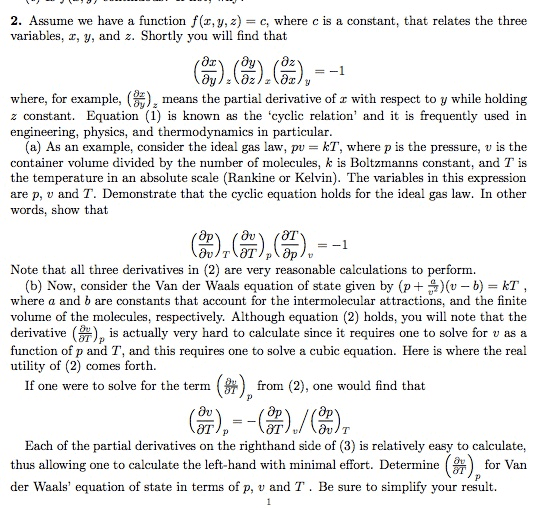MAT 21C Lecture Notes - Lecture 20: Partial Derivative, Heat Capacity

MAT 21C – Lecture 20 – Partial Derivatives for Multi-Variable Functions
• Partial Derivatives: Suppose we have a function of two variables, f(x, y). Then the
partial derivative of f with respect to x annotated as: or
is the derivative
that treats y as a constant (y is held fixed). The partial derivative with respect to
y annotated as: or
is the y-derivative with x held fixed.
• Example: If , find and .
To find, , we treat as constants. Then
. Following similar logic,
Here, we treat as constants.
• Formal Definition:
and
.
• Example: Let
.
Suppose . Then it implies that for any non-zero value of x and non-zero
value of y,
What about
and
?
Suppose, we set only y = 0. Then
Since
for any value of x, then it implies that
. Similarly, if we set x = 0,
then
find more resources at oneclass.com
find more resources at oneclass.com

52
MAT 21C Full Course Notes
Verified Note
52 documents
Document Summary
Mat 21c lecture 20 partial derivatives for multi-variable functions: partial derivatives: suppose we have a function of two variables, f(x, y). Then the that treats y as a constant (y is held fixed). To find, (cid:1858)(cid:3051)(cid:4666)(cid:1876),(cid:1877)(cid:4667), we treat (cid:1857)(cid:3052),(cid:1877),(cid:1856) (cid:1877)(cid:2871) as constants. Here, we treat sin(cid:4666)(cid:1876)(cid:4667)(cid:1856) (cid:1876)(cid:2870) as constants: formal definition: (cid:1858)(cid:3051)(cid:4666)(cid:1876)0,(cid:1877)0(cid:4667)= lim 0(cid:4666)(cid:3051)0+ , (cid:3052)0(cid:4667) (cid:4666)(cid:3051)0,(cid:3052)0(cid:4667) and (cid:1858)(cid:3052)(cid:4666)(cid:1876)0,(cid:1877)0(cid:4667)= lim 0(cid:4666)(cid:3051)0, (cid:3052)0+(cid:4667) (cid:4666)(cid:3051)0,(cid:3052)0(cid:4667, example: let (cid:1858)(cid:4666)(cid:1876),(cid:1877)(cid:4667)= {(cid:882),(cid:1876)(cid:1877) (cid:882) (cid:883),(cid:1876)(cid:1877)=(cid:882). Then it implies that for any non-zero value of x and non-zero value of y, (cid:3051)(cid:4666)(cid:1876),(cid:1877)(cid:4667)= (cid:3052)(cid:4666)(cid:1876),(cid:1877)(cid:4667)=(cid:882). Since (cid:3051)(cid:4666)(cid:1876),(cid:882)(cid:4667)= (cid:882) for any value of x, then it implies that (cid:3051)(cid:4666)(cid:882),(cid:882)(cid:4667)=(cid:882). We know that (cid:1858)(cid:4666)(cid:1876),(cid:882)(cid:4667)=(cid:883) and (cid:1858)(cid:4666)(cid:1876),(cid:1876)(cid:4667)=(cid:882) (cid:1875) (cid:1876) (cid:882). Sometimes, we write (cid:4666)(cid:3051)(cid:4667)(cid:3052) partial derivative with x and y fixed. derivatives with two variables. The equation for its state is represented by = (cid:4666),(cid:4667). The second derivative of (cid:1858)(cid:3051) with (cid:1858)(cid:3051)= (cid:885)(cid:1876)(cid:2870)(cid:1877)+(cid:1857)(cid:3051)sin (cid:4666)(cid:1877)(cid:4667) respect to y is (cid:1858)(cid:3051)(cid:3052)=(cid:885)(cid:1876)(cid:2870)+(cid:1857)(cid:3051)cos (cid:4666)(cid:1877)(cid:4667) (cid:1858)(cid:3052)=(cid:1876)(cid:2871)+(cid:1857)(cid:3051)cos (cid:4666)(cid:1877)(cid:4667)


